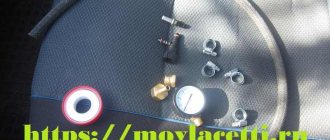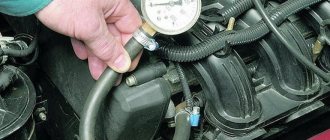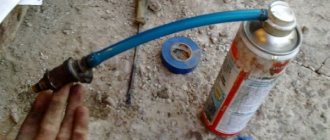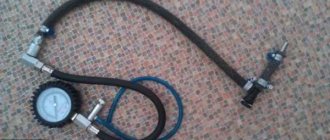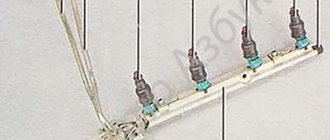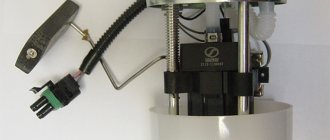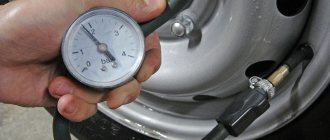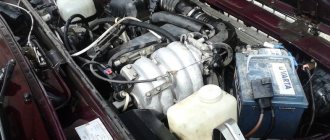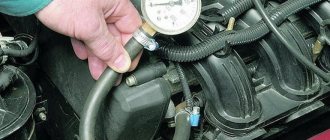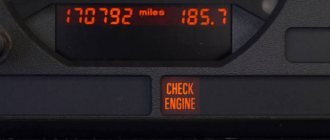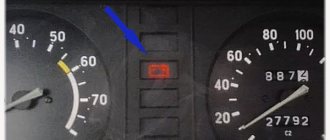Injector purpose
Installing an injector in the VAZ 2107 made it possible to significantly improve engine performance. Changing the type of fuel system increases the amount of energy that is produced during the combustion of gasoline. Compared to a carburetor engine, a fuel injection system is more efficient in the initial stages, but over time its performance decreases. What does this depend on?
VAZ 2107 injector plays the role of the final element in the fuel system of the car. The air mixture, together with a cloud of atomized gasoline, creates a huge amount of energy. Over time, this atomization may become less effective, the fuel jets will become weaker, and all due to low-quality gasoline.
The main cause of injector failure is poor fuel. Car fuel consists of many chemical components; in addition, various impurities are added to it, which should improve the overall performance of the engine. This factor cannot be ignored, since such gasoline leaves sediment on the walls of the fuel system. The thinnest channels are in the injectors, and it is these devices that suffer first. VAZ 21074 injector has the same problem. During operation, deposits from fuel only accumulate. What needs to be done to stop this?
Replacing the fuel pressure regulator VAZ-2107-20
The fuel pressure regulator is a fuel valve connected to a spring-loaded diaphragm
The valve is closed under the action of the spring. The diaphragm divides the regulator cavity into two isolated chambers - fuel and air.
The air is connected by a vacuum hose to the receiver, and the fuel is connected directly to the ramp cavity.
When the engine is running, the vacuum, overcoming the resistance of the spring, draws in the diaphragm, opening the valve slightly.
On the other hand, fuel exerts pressure on the diaphragm, also compressing the spring.
As a result, the valve opens and part of the fuel is released through the drain pipe back into the tank.
When you press the gas pedal, the vacuum behind the throttle valve decreases, under the action of a spring, the diaphragm closes the valve, and the fuel pressure increases.
If the throttle valve is closed, the vacuum behind it is maximum, the diaphragm pulls the valve harder - the fuel pressure decreases.
The pressure range supported by the valve is determined by the spring stiffness and the diameter of the valve opening and cannot be adjusted.
The pressure regulator is non-separable; if it fails, it is replaced.
We carry out the work on a cold engine.
Relieve pressure in the fuel system.
Disconnect the vacuum hose from the fuel pressure regulator.
Using a Phillips screwdriver, unscrew the screw securing the fuel pipe holder to the receiver bracket and remove the holder.
Using a 24mm wrench, unscrew the union nut securing the drain tube to the pressure regulator.
Use a 5mm hex to unscrew the two screws securing the fuel pressure regulator to the rail.
We remove the regulator pipe from the hole in the ramp and remove the regulator from the tip of the drain tube.
The connection between the regulator pipe and the ramp is sealed with a rubber ring.
If the ring is torn, deformed or has lost elasticity, replace it with a new one.
The connection between the regulator and the tip of the drain tube is also sealed with a rubber ring.
If the ring is torn, deformed or has lost elasticity, replace it with a new one.
Install the regulator in reverse order. The tightening torque for the screws securing the regulator is 8–11 Nm, and the union nut for securing the drain pipe is 20–34 Nm.
Cleaning and preventing plaque in the system
The injector device is very sensitive to large inclusions in gasoline. If you are using a cheap brand of fuel, be prepared to change your injectors soon. So the first thing you should do for your VAZ fuel pump is change the brand of fuel. The power supply system of the VAZ 2107 should become cleaner; the possibility of plaque formation in the system is still not excluded. Since the flammable liquid in the channels occasionally stagnates and sometimes even freezes, an early breakdown can be prevented only in one way - regular cleaning.
Approximately every 35-40 thousand km it is necessary to carry out preventive cleaning work on the fuel system. You need to wash the channels with your own hands. The performance of the engine will depend on the quality of cleaning. If this procedure is carried out irregularly, then soon you can say goodbye to one injector and look for a new one, and then you will have to change the remaining elements of the VAZ fuel pump.
In 4-cylinder types of injection engines, different intensities of injector clogging are observed. The temperature in the area of cylinders 2 and 3 is always elevated, so sediment accumulation occurs there faster.
A special admixture of polyetheramine is considered a prophylactic agent in such cases. It prevents the accumulation of burning for a long time.
Checking the pressure in the fuel rail yourself
In order to perform the test, you will need a pressure gauge with a maximum value of 7-10 atmospheres. I do not recommend using a more powerful pressure gauge, since it will have a large error when measuring small pressure.
In addition to the pressure gauge, you must have a hose with an internal diameter of 9 mm, as well as tow (which is used for plumbing work). This will ensure a tight connection. Next, we strengthen all the joints with special clamps. If you don’t have the desire to “tinker,” you can buy a ready-made device for measuring pressure in the ramp.
Damage diagnostics
How to understand that an injector needs to be replaced, checked or repaired? Even without sensors, you can understand that repair of fuel system elements is required if there are 1 of 2 main signs in models 2107, 21074:
The cause of such failures is clogged injectors; even diagnostics are not needed. Cleaning helps restore the engine to its original performance. If the problem has not been resolved after cleaning, it is worth checking the tubes and injectors for damage or breakdowns. In such cases, it is better not to start repairs, but simply replace the damaged parts with new ones.
Sometimes it is impossible to determine on your own where the damage is, and only then will diagnostics at service centers come in handy. A blockage can cause quite serious damage to the VAZ 2107 injector, as well as rupture of channels. The pressure that arises inside the system can easily destroy the most fragile parts. Here you won’t be able to fix the situation with your own hands, even if you have a complete diagram of the car at hand. There is only one conclusion - you need to devote a lot of time and attention to cleaning injectors and do it regularly.
When to check fuel rail pressure
If problems arise in the fuel system, with a high degree of probability they can be associated with rail pressure.
The following main malfunctions can be identified that indicate the need to check the pressure in the fuel system:
- The car began to consume significantly more fuel;
- The engine operates unstably at idle, including stalling;
- The motor is tripping;
- Engine exhaust contains high CO content.
The malfunctions listed above are also typical when a number of other problems occur. In particular, before checking the pressure in the fuel rail, it is recommended to make sure that the electronic control unit is working properly.
Why do you need a fuel pressure regulator?
As mentioned above, this regulator maintains the required fuel pressure necessary for normal operation of the injectors, taking into account one or another operating mode of the power unit. In other words, the RTD affects the amount and intensity of the fuel supply that enters the engine cylinders through the injectors.
Simply put, the amount of fuel supplied to the engine at the time of injection depends on the pressure that is created inside the fuel rail (rail), as well as on the pulse duration for opening the injector and the vacuum in the intake manifold.
For more accurate dosing and maintaining constant pressure, a diaphragm valve-regulator is used, which experiences fuel pressure on one side, and a spring force on the other. RTD is used in power systems where there is a so-called “return”. The regulator is installed at the fuel rail. Also, this element can be located in the fuel tank, while such systems do not have a return line.
Preparatory stage when checking the pressure in the fuel system of the VAZ 2115
The pressure in the fuel system is checked in four different operating modes of a car engine:
Some fuel systems range from 30 to 40 psi, while others range from 50 to 60 psi or more. Once you know what your fuel pressure is, you'll want to go and look at your vehicle's correct specifications to see if your fuel pressure falls within factory specifications. If the pressure is low, you will need to make sure that the filter and high pressure line are not pinched or clogged in any way.
Also, make sure the pump has full battery voltage and a good ground before replacing it. There are two types of fuel systems. Systems with a fuel return line to the fuel tank and systems that do not use a fuel return line. Fuel systems that use a fuel pressure regulator located on the fuel rail will return back to the fuel tank. Those that do not use a fuel pressure regulator on the fuel rail will not have a return line to return fuel to the fuel tank.
- with the ignition on
- at idle
- with the tube removed from the fuel pressure regulator (RDT)
- with a pinched return line.
Wherein:
- when the ignition is on, the pressure should be about 3 atm. (not less),
- at idle speed - about 2.5 atm.,
- with the RTD tube removed - about 3.3 atm.,
- with a pinched drain pipe (return) - about 7 atm.,
- when adding gas, the pressure increases to 3 atm, then drops to 2.5 atm.
Fuel pressure regulator malfunctions
Problems in the engine power system can vary. For this reason, during diagnosis it is necessary to look for certain signs of a malfunctioning fuel pressure regulator. Most often, the main symptoms are considered to be when the engine does not pick up speed and does not develop full power, and also stalls in different operating modes. In the list of main signs, experts note:
Note that the malfunction of the RTD on gasoline cars is similar in symptoms to common problems with the fuel pump or its strainer. For this reason, when determining faults in the power system, a mandatory check of the fuel pressure regulator is necessary.
In other words, if the car stalls at idle, the engine power is lost, dips appear, the car jerks during acceleration or when changing gears, significant fuel consumption is noted, then the problem may not only be in the fuel pump grid, the motor or its relay, but also in the fuel pressure regulator.
Regulator malfunctions usually come down to the fact that the spring loses the required force, as a result of which the fuel is prematurely drained into the “return”, and the engine simply does not have enough fuel when you press the gas and increase the speed, as well as in transient modes. It turns out that the pressure in the fuel rail when the fuel pressure regulator spring is faulty is low, as a result of which the engine runs unstably, engine power decreases, the ECU is not able to correctly adjust the mixture composition for different operating modes, etc.
Failures in the operation of the RTD are also possible when the pressure regulator in the fuel rail begins to jam at certain intervals. In such cases, pressure drops occur in the fuel supply system, and the car begins to twitch. Let us add that the most common reasons for regulator failure, which results in signs of malfunction of the fuel pressure regulator on a diesel or gasoline car, also include wear and tear of the materials inside the device, that is, the valve simply wears out its service life over time. The service life and condition of the regulator are affected by the quality of the fuel and the content of various impurities in it, long periods of vehicle downtime without starting the engine, etc.
Pressure regulator of the fuel supply system of the injection engine of VAZ 2108, 2109, 21099 cars
The pressure regulator is an element of the fuel supply system (power system) of the injection engine of VAZ 2108, 2109, 21099 cars.
Purpose of the pressure regulator
The pressure regulator is designed to regulate the fuel pressure in the power system and maintain it within specified limits, ensuring the correct functioning of the injection system at different engine operating modes.
Location on the engine
In the fuel systems of VAZ 2108, 2109, 21099 vehicles, the fuel pressure regulator is installed on the engine fuel rail, to the left in the direction of travel of the vehicle.
Fuel pressure regulator device
The fuel pressure regulator VAZ 2108, 2109, 21099 is a membrane-type valve that opens when the fuel pressure increases and passes it through the drain line back into the gas tank. The regulator is attached to the ramp with two bolts (5 mm hexagon). The connection between the regulator and the ramp is sealed with a rubber ring. A vacuum supply hose is placed on top of the pressure regulator fitting, and a return line drain pipe is attached to the bottom using a 24 mm nut.
A membrane (diaphragm) is installed inside the pressure regulator, dividing its cavity into two isolated parts (one with fuel, connected to the ramp, the other is supplied with vacuum from under the throttle valve). The membrane is connected to a valve, which unlocks or, conversely, closes the outlet to the drain line. On the opposite side, the membrane is supported by a return spring.
Operating principle of the pressure regulator
The pressure regulator maintains fuel pressure in the fuel rail within 2.8 - 3.2 bar. This pressure is necessary for the injectors to work properly. If the fuel pressure exceeds the specified limits, the membrane moves inside the regulator body, overcoming the resistance of the return spring and opening the shut-off valve connected to it. The fuel is discharged through the valve into the return line. The pressure drops, the membrane moves the valve back, stopping the fuel drain.
In addition, the operation of the regulator is affected by the opening or closing of the throttle valve and, accordingly, an increase or decrease in the load on the engine. As the load increases, more pressure is required in the fuel rail, and as the load decreases, less pressure is required. To do this, vacuum is supplied to the space behind the regulator membrane from the engine receiver. If it is present or absent, the membrane, acting on the valve, closes or opens the fuel discharge.
When the throttle valve is closed (for example, idling), the vacuum in the engine intake manifold is high and the diaphragm is pulled back, opening the valve. The fuel is discharged, the pressure in the fuel rail drops.
After pressing the gas pedal, the vacuum behind the throttle valve drops and, accordingly, this drop is transmitted through the hose to the behind-the-diaphragm space of the regulator. The diaphragm (membrane) moves forward under the action of a spring, acts on the valve and it closes the fuel discharge. The pressure in the fuel rail increases, which improves the efficiency of the injectors.
Checking and replacing the fuel pressure regulator
As you can see, a malfunctioning pressure regulator has symptoms very similar to a malfunctioning fuel pump or a clogged fuel filter. At the very beginning, we note that if problems with this element are detected during the inspection, then it is preferable to replace the RTD with a new one. The fact is that replacing individual parts, cleaning attempts and other manipulations often do not allow the device to return to proper functionality. Considering that the price of a fuel pressure regulator is quite affordable, then any repair attempts can be considered impractical.
Measurements should show changes in pressure in the system within a certain range. The fuel pressure should increase, being within the range of 0.3 - 0.7 Bar. If this does not happen, then first you can try replacing the vacuum hose, and then repeat the measurements. To check the fuel pressure at the end of the ramp, you will need to unscrew the fitting plug. This plug also has a special ring for sealing. The specified ring should be checked for integrity; the element should remain elastic. If there are defects, then the ring or the entire plug also needs to be changed at once.
The VAZ 2107 injector power system has some differences from the classic carburetor. The main distinctive features are caused precisely by the fact that instead of a standard system for supplying the air-fuel mixture to the cylinders, the new VAZ 2107 models use an injector. Accordingly, other elements, such as a pump, filter, etc., differ. In addition to the indicated differences in the fuel system, the VAZ 2107 injection engine has fundamental differences in the ignition system. At the same time, the undeniable advantage of this type of engine is the presence of electronic control of all major systems. It is thanks to it that the efficiency and efficiency of the engine significantly increases.
The schematic diagram of the fuel supply system for the VAZ 2107 injector is shown in the following figure.
Here the main elements are indicated by numbers from 1 to 12:
In addition, the power circuit contains a system for cleaning and subsequent saturation of air with gasoline vapor, consisting of a fuel purge valve 8 and an adsorber 12.
As you can see, the power supply system of the VAZ 2107 injector has a number of significant differences, therefore, the procedure for its maintenance has its own characteristics. As for the air filter, everything is exactly the same as in the case of a carburetor. The filter element is replaced during each routine maintenance.
The pump does not require special maintenance, except for cleaning the fuel strainer installed on the suction pipe. This mesh traps mechanical impurities present in gasoline poured into the tank. If the fuel pump fails, it is replaced. To do this, it is necessary to disassemble the tank, remove the entire pump assembly from it, after which the failed element is replaced. The repaired pump is installed in its regular place in the tank.
The fuel filter is replaced periodically, in accordance with the manufacturer's recommendations. The main element is a special paper insert assembled in a metal case, and it is installed in the supply pipeline between the fuel pump and the injection system. The direction of fuel movement is indicated by an arrow on the body. For example, according to the arrows in the following photo, the pump (fuel tank) should be connected on the right side, and the ramp on the left.
The fuel injection system or fuel rail of the VAZ 2107 engine injector is designed directly to supply the mixture to the engine cylinders.
One of the main working elements of the VAZ 2107 engine injection system is the injector. It is essentially an electromechanical valve that is controlled by the engine management system. When voltage is applied, the valve opens and the mixture is injected into the cylinder through the nozzle under the pressure created by the pump. During operation, the nozzles become clogged and therefore require periodic cleaning. As a rule, injectors are cleaned during maintenance, but if engine performance deteriorates, they need to be cleaned without waiting for routine maintenance. Injectors are replaced only when they fail.
How to check the pressure in the fuel rail of a VAZ 2114
In order to find out what level of gasoline pressure is maintained in front of the injectors, you need to find out where the TR is located, inspect the fuel supply hoses to the RTD and the “return” hose, that is, the hose through which excess gasoline is drained into the fuel tank. You will need to work with these tubes when measuring the gasoline pressure in the TR. In addition, you need to prepare the necessary tools and materials:
In contrast, when a wide-open naturally aspirated engine is closed, the manifold pressure is not in a vacuum or boost state, so the effective pressure is 58 psi of rail pressure and no more.
This reduces the final output of the injectors. Some non-return systems will actually change the pump output to emulate the referenced system, or to increase fuel pressure at higher demands and less fuel pressure at lower demands. Such systems offer the best of both worlds. Ultimately, we need to know what the effective fuel pressure is in any given situation.
- a pressure gauge, for measurements it is best to take a mechanical one, with the least possible readings - 7-10 kg/cm2, because a pressure gauge with large readings will give a large error in measurements;
- a hose that can operate under high pressure, preferably fuel or oxygen, with an internal diameter of 8 - 9 mm
- 2 - 4 clamps for securing hoses
- screwdriver and pliers
- cap for twisting nipples in car tires
- a container, preferably wide, to collect fuel when it is drained into the TR
- rags
Measuring pressure in the fuel rail must be carried out in four modes:
If your fuel pressure regulator is not working well, your car may display several different symptoms. This article lists and explains the most common ones. Check your fuel pressure regulator if you notice the following.
Remove the spark plug and inspect it. If it's soot, it could be a sign of a bad fuel pressure regulator. If you find a plugin in this state, check the others. The spark plug itself could simply mean that the engine is burning oil in that head.
If you replace your fuel pressure regulator, you may also want to replace your forks. They can be plugged from the bad fuel pressure regulator. You can try just cleaning them and returning them, but if your engine is still running rough, get new ones.
- with the ignition on - in this mode the pressure should be at least 2.9-3.0 kg/cm2.
- in low speed or idle mode - pressure is not less than 2.5 kg/cm2.
- with the hose disconnected from the RTD - the pressure is maintained within 3.3 kg/cm2.
- with a pinched hose for draining excess fuel back into the tank - the pressure increases to 7.0 kg/cm2.
- when overgassing, it increases abruptly to three and then drops to two and a half atmospheres
After everything is prepared, you can start working.
Engine does not run smoothly
Speaking of poor engine performance, if you are idling the engine and it is running rough, change the oil filter and check the pressure regulator to resolve poor fuel pressure. Another sign that your engine is suffering from the effects of a bad fuel pressure regulator is if you are having trouble starting. It won't turn over several times before it starts.
Tail pipe emits black smoke
Having black smoke coming from your tail pipe is a sure sign that something is wrong with your fuel pressure regulator. The normal color of any smoke coming out of the exhaust should be white or gray, not black, so if you see the latter, there is a definite mistake.
Attention! Before you start taking measurements, make sure that the fuel system maintains a tight seal and that there are no leaks or microcracks anywhere. Otherwise, the measurement results will be unreliable.
- Insert a pressure gauge into one end of the prepared hose and secure the connection tightly with a clamp.
- At the fuel pressure fitting, located in the free end of the TP, opposite to the one on which the RTD is located, unscrew the plastic cap covering the nipple.
- Place an empty container to collect gasoline and press the cap to twist the nipples to release the residual pressure in the fuel rail;
- Without removing the container, unscrew the nipple using the same cap. The locking nipple is absolutely identical to those installed in car wheels.
- After this, put the free end of the hose prepared for testing onto the fitting. Before doing this, put a clamp on the free end.
- Tighten the clamp securely on the fitting, avoiding any leakage.
- Using a fuel pump, pump fuel into the TR.
- Turn on the ignition and use a pressure gauge to check the pressure created in the cavity of the fuel rail. It should be 2.9-3.0 kg/sq. cm., no less. If the readings drop to zero, it means the fuel pressure regulator or fuel pump check valve is faulty.
- The next step is an idle test. Start the car engine and check the pressure gauge readings. The arrow must be in a position of at least 2.5 kg/cm2. If in this mode a pulsation of up to 0.2 atmospheres occurs, then it is necessary to clean or replace the coarse filter in the fuel tank.
- Before measuring the pressure in the fuel rail to check the RTD, it is necessary to disconnect the vacuum hose coming from the intake manifold from it. The pressure should increase to 3.3 kg/cm2, a value of 3.0 atmospheres is also considered acceptable. If it does not change, or changes slightly, then, with a high degree of probability, the fuel pump in the fuel tank has failed.
- Finally, the pressure is checked with the return line turned off. To do this, use pliers to pinch the return hose running from the RTD to the fuel tank, through which excess gasoline is discharged. The pressure should increase to a maximum of 7.0 kg/cm2. A value of 6.0 atmospheres is considered acceptable, and anything lower indicates severe wear of the pump. Drop less than 4.0 kg/cm2. indicates a clogged fine filter or pipelines in this line.
Gasoline scented sticks
Check the dipstick and make sure you smell fuel. If you do this, it could be a symptom of a bad fuel pressure regulator, which would allow gasoline to leak into the oil system.
Gasoline drops from the shank
Gasoline leaking from the exhaust pipe is the result of your tank being overfilled or a bad fuel pressure regulator.
Most likely, gas is flowing into the exhaust system because the fuel pressure regulator allows it to flow into the line. If the engine stops when you press the gas pedal, check the fuel pressure regulator. There shouldn't be any hesitation when you step on the gas. Even if you notice a slight fluctuation, have the pressure regulator checked because it may just start going bad.
The fuel system of a modern car is the most important line that feeds the internal combustion engine and ensures its performance. Its condition determines how efficiently and economically it will work, and sometimes the safety of the entire car depends. Therefore, an important task for a car enthusiast is constant vehicle prevention.
Gasoline is in the vacuum hose
If you notice any of the symptoms above but aren't sure if a bad fuel pressure regulator is the cause, there are some things you can do to be sure one way or another.
Remove the vacuum hose that attaches to the fuel pressure and make sure the engine is not running. If in line, your fuel pressure regulator is bad. Also, if there is no line, but when you turn the switch on, fuel comes out of the hose, that's bad. Often fuel pressure is the last thing checked when it should be one of the first. If the fuel pressure is below the listed specifications anywhere in the acceleration range, you are faced with limited options. Firstly, it’s lightweight: the built-in fuel filter can simply become clogged. However, this figure assumes that the gasoline you buy is free of dirt and impurities. This may not always be the case, especially in times of high fuel costs when many people buy on price rather than quality.
Pressure in the fuel system of VAZ 2115
- one of the important parameters when diagnosing a car. The behavior of your car in different modes depends on this parameter.
The main signs by which you can determine the presence of malfunctions in the fuel system:
- “Trippling” of the engine or interruptions in operation.
- The idle speed fluctuates, the engine stalls at idle speed.
- Excessive fuel consumption.
- Increased CO content in exhaust gases.
Confirmation (or refutation) of the assumption that the vehicle’s fuel system is faulty is possible after checking the pressure in it.
The replacement procedure is usually described in the Routine Maintenance section of repair manuals. If you decide to do this yourself, you will follow all recommended safety precautions for working with gasoline. While you are under the vehicle, visually check the integrity of the fuel line from the tank to the engine compartment, looking for leaks or dents that could reduce or limit fuel pressure. These pumps are electrically powered and controlled by a fuel pump relay inside the engine compartment.
When the ignition is turned on, the fuel pump runs for a few seconds to pressurize the system to start, then stops. Once the engine is running, the fuel pump maintains constant fuel pressure to the injectors. Electric fuel pumps may interrupt suddenly or slowly, silently or with a warning. In addition to receiving a low pressure reading on the fuel pressure gauge, an intermittent electric fuel pump may also make a noticeable whining noise, especially noticeable when the fuel level in the tank is low.
To measure the pressure in the fuel system, you can buy a special fuel pressure measuring device. This is a ready-made kit consisting of a fuel pressure gauge, adapter and drain. The second option is to measure the fuel pressure at a service station. There is an option to check the pressure yourself.
Checking the pressure in the VAZ 2115 ramp
in the conditions of your garage will not require special devices. To check the pressure you will need a regular mechanical pressure gauge. Moreover, if the pressure gauge has a scale, for example, up to 16-20 atm., the result of measuring the pressure in the fuel system of the car can give a large error. This is due to the fact that for fuel the limit is much lower and amounts to 5-7 atm. It is correct to check the fuel pressure with a pressure gauge with a maximum value of 10 atm. (ideally 6-7 atm.). You also need to have a fuel (or oxygen) hose with a diameter of 9 mm, tow (to ensure a tight connection) and clamps.
Once low fuel pressure is traced to the fuel pump, a new pump is the only option and is usually something you want to leave to a professional mechanic. Another tip: Some mechanics advise owners of vehicles with in-tank fuel pumps to keep the tank at least one-quarter full whenever possible. This allows the pump to sink into the fuel, cool it and prevent premature failure from overheating.
Checking fuel pressure is very important in diagnosing an engine performance problem. Depending on the application, it will take anywhere from a few minutes to several minutes to connect. On most systems you can screw directly into the fuel rail at the pressure test port, while others you will have to go into the line by removing the fuel line from the rail or even the line from the filter and installing a pressure gauge between the two to get an accurate reading. talk to a live mechanic if you need help.
To make a device under the pipe, we wind tow, put on an oxygen hose and tighten it with clamps.
Before starting to measure pressure, it is very important to make sure that the fuel system is intact and that there is no depressurization, otherwise your measurements will not be accurate.
Checking the pressure in the fuel rail on all VAZ cars
Welcome! Pressure in the fuel system - in any car there is pressure in many systems, for example, in the engine lubrication system there is oil pressure, in the engine power system there is fuel pressure, etc., so most of the fluids that are in the engine are supplied under pressure, because that if, for example, there is no pressure in the lubrication system, then the engine oil will lubricate the engine very poorly and thus it will quickly wear out, and if the pressure in the engine power supply system suddenly disappears, the car will begin to twitch, stall and will not drive well, therefore The pressure in the engine must be monitored and always kept normal.
Note! In order to check the pressure in the fuel rail, you will need to stock up on only one pressure gauge, which is specifically designed for checking fuel pressure, but a pressure gauge used to check tire pressure may also be suitable; when purchasing a pressure gauge, it will have to come with a hose, but not in all cases , sometimes pressure gauges are sold separately without a hose, in this case you can use any of your own hoses or buy one specifically for the pressure gauge in a car store! (So that you know approximately what a pressure gauge for checking fuel pressure with a hose looks like, just below there is a photo in which it is depicted)
Which part should be used to check the pressure in the engine? In fact, the pressure can only be checked at the fuel rail, but also with the help of additional tools, the fuel pressure can be checked in other places, but as practice shows, this is not entirely necessary, since you can only understand what the problem is using one fuel rail, you will learn how to do this today in this article.
Note! So that you further understand what we are talking about, we will explain to you one thing that some people already know and some still do not understand what we are talking about, so two systems were mentioned earlier, namely the lubrication system and the engine power supply system, so about the lubrication system we won’t discuss it with you today since it doesn’t relate to our topic, but let’s talk a little about the engine power system. Due to the power system, the engine absorbs air and gasoline, because the car only works on a mixture of these two things, that is, if If the car doesn’t take in air, the car most likely won’t even start, and if the car doesn’t take in gasoline, then it won’t start either, so in order for the engine to work normally and stably, it needs to be constantly fed, and it is fed gasoline and air, as was said earlier, and if one of the parts that, for example, supplies gasoline fails, then the car will no longer drive, this is why checking the fuel pressure in the system was invented, because if the fuel pressure is at zero, then Accordingly, gasoline will not flow into the car’s engine and thus the car will not go anywhere! (If you are interested in what parts relate to the engine power system, then look at the article entitled: “Reducing pressure in the power system on a VAZ”, this article contains a photograph that shows all the parts that relate to this system)
When should you check the fuel rail pressure? The pressure in the rail is checked only if there are at least some signs that indicate poor pressure in the fuel system, and these signs include: Unstable engine operation, stopping at idle, as well as increased or decreased engine speed car, when driving due to low pressure, the car may still twitch and not develop its full power.
Checking the pressure in the fuel rail on VAZ and Lada cars with an injection engine
The article will describe a testing technique that does not require special devices.
From the tool you will need:
- Any mechanical pressure gauge with a maximum reading from 6 to 10 atmospheres (0.6-1.0 MPa)
- 8 or 9 mm fuel or oxygen hose
- Cap for unscrewing nipples on the wheel
- Two clamps
- Pliers
1. We took a regular gas pressure gauge with a scale of up to 1.0 MPa. It has a threaded connection and screws perfectly onto a 9 mm oxygen hose. You can use a mechanical one to check tire pressure. They are usually inserted into the fuel hoses by 8 mm.
2. Screw it into the hose and tighten it with a clamp:
3. Unscrew the plastic cap from the fuel rail. It should unscrew by hand, but if it hasn’t been touched for a long time, you may need pliers:
4. If the car has just been turned off, then the gas in the ramp is under pressure. First, it is recommended to release the pressure by pressing on the spool and placing a rag or a plastic “bottle” with the neck cut off. It is more convenient to bleed using a wheel cap.
5. Unscrew the nipple with the cap. It is similar to a wheel nipple:
6. We put a hose with a pressure gauge on the threaded part and tighten the connection with a clamp:
7. Start the car and first of all make sure that there are no gasoline leaks from the connections. Then we look at the pressure gauge readings.
8. For fuel systems with “return” (a pressure regulator is installed on the fuel rail, from which a tube goes back to the tank), a pressure of 2.7 atm is considered normal (when re-gasping it should jump up to 3 atmospheres). However, a pressure of 2.5 atm is also acceptable. If the pressure is less, then the fuel system is faulty. Pressure pulsation (0.2 atm) indicates a clogged coarse mesh (located in the tank with the fuel pump).
9. Next, we check the pressure regulator. To check, disconnect the hose going from the regulator to the intake manifold. The fuel pressure should increase to 3.2 atm (at 2.7 initial). Up to 3.0 atm is also acceptable. If the pressure has not changed or changed only slightly (0.1-0.2 atm), then you need to check the fuel pump.
10. The maximum pressure developed by the pump is checked. To do this, use pliers to pinch the return fuel line (coming from the regulator). Different pumps show different pressures, but a new one should have at least 6 atm. A pressure of 5 atm indicates severe wear, but will still serve. If the pressure is less than 4.0 atm, the pump is faulty or the pipeline with the fine filter is clogged. If the fuel pump is working properly, and the pressure in the rail drops after the “return” is restored to less than 2.5 atm, and/or does not change when the regulator hose is disconnected, then the regulator is faulty. If, when the return line is pinched, the pressure rises slightly, and engine performance deteriorates significantly, then there is a high probability of injector leakage.
11. To eliminate the influence of the injectors, it is better to measure the pressure on the supply line itself by disconnecting it from the ramp and inserting it into a hose with a pressure gauge. If the pressure has risen to 5-6 atm, and with the “return” compressed it is significantly less, then the injectors are allowed to pass through. It is necessary to remove the ramp and check the condition of each individually.
12. You can check for clogging of the pipeline as follows. Remove the rear seat and unscrew the hatch. We see the fuel pump assembly underneath it. If the pipeline has quick-release connections, then we buy such a connection in the store (50 rubles).
13. If the pipeline is installed on threaded connections, you will have to buy the entire tube and cut off the tip:
14. Connect it to the pump outlet, and put a hose with a pressure gauge on the other end. Let's check the pressure again. If the pressure gauge readings increase to the normal 6 atm (after pumping gasoline several times by turning the key), then change the fine fuel filter and bleed (or flush the entire system).
15. Replacing the fuel filter is shown here: replacing the fuel filter on Lada Priora, Kalina and Granta cars. The only difference is that after removing the filter, we direct the fuel supply hose into a plastic bottle (preferably transparent) and turn on the ignition with the key (the fuel pump turns on and fuel spills into the bottle). We inspect the condition of the fuel in the bottle. Then we install a new filter, remove the hose from the ramp and direct it into the bottle. We turn on the ignition several times and spill gasoline. We inspect the fuel in the tank again. If dirt is found after the filter, then washing the injectors is also required. We assemble the entire system and measure the pressure readings again. If the readings have not changed, then check the correct clamping of the “return” (you can try connecting a pressure gauge to the output of the regulator). If this does not help, then perhaps the blockage is serious and requires blowing with air under high pressure. It would be a good idea to check the entire pipeline from the tank for mechanical damage (dents, kinks).
What pressure should the fuel system have?
- When the ignition is turned on, the pressure in the system should be ~ 3 atm no less.
- At idle, the device should show ~ 2.5 atm.
- When the fuel pressure regulator tube is removed, the pressure gauge should show ~ 3.3 atm.
- With a pinched drain tube in a working ramp there will be ~ 7 atm.
- Podgazovka should increase the pressure to 3 atmospheres, then decrease to 2.5 atm.
- After the fuel enters the system, turn off the ignition and watch what the pressure gauge shows. In a working rail, the pressure should drop to 0.7 bar, and then stabilize at this mark.
- If the pressure instantly drops to zero, the fuel pressure regulator (FPR) is most likely faulty. The RTD will need to be removed and replaced, or the check valve of the fuel pump motor will have to be replaced.
- Increase the rpm to 3000 and watch the pressure gauge needle; if it goes down, you definitely have a problem with the fuel pump.
- If the fuel pump does not create the required pressure for a long time, the mesh or fuel filter of the fuel pump is most likely clogged.
- If none of the above options are confirmed, a more detailed diagnosis is most likely required, which includes checking: TPS, IAC, mass air flow sensor, as well as compression in the engine cylinders.
Source:
Symptoms of a problem
As a rule, checking the pressure in the fuel rail is required in the following cases:
- If malfunctions occur in the operation of the power unit at XX. In such a situation, the car may stall at the most unpredictable moment (even at a traffic light);
- the motor begins to stall, obvious instability appears in its operation;
- Significant excessive consumption of gasoline is noticeable. Consumption can generally increase by 30-50%;
- the volume of carbon monoxide in the exhaust increases.
This problem may “pop up” during inspection at stationary points and lead to a serious fine.
Please note that the symptoms we mentioned can also be caused by other problems - a clogged filter in the fuel system, a defect (malfunction) of spark plugs, bad fuel, and so on.
But if the initial inspection does not produce results, and the ECU does not generate errors, then checking the pressure in the ramp is mandatory.
Step-by-step instructions - how to check the pressure in the fuel system
Important note! Before checking the pressure in the fuel system, make sure that it is intact and not depressurized, otherwise your measurements will not be accurate.
- First of all, open the hood and turn off the ignition.
- Then we find the fuel rail of the injectors.
- We unscrew the plug of the fuel pressure fitting and, using the spool, unscrew the nipple.
- Prepare some kind of rag or utensil for residual fuel that may splash (Be careful with your eyes!).
- Connect the hose of our device to the fitting and secure it using the same clamp.
